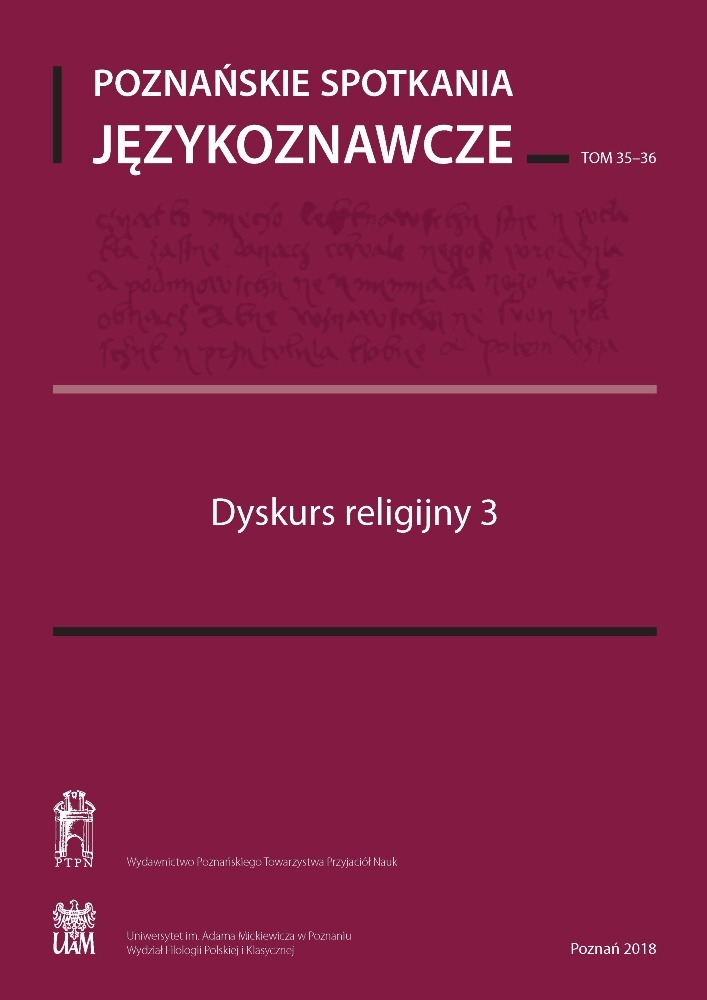Abstract
The author analyses meditative reflections by Karol Wojtyła – John Paul II, collected in a volume entitled I Am so Much in God’s Hands. Personal Notes, 1962–2003 (Krakow 2014). The author examines the fragments of the text in which the speaker is identical with the addressee, and where internal prayer acts: meditations, contemplations and adorations. They are components of a reflection day or a religious retreat defined as a macro-genre (a collective genre). When expressed through language, internal prayers can be viewed in their text-typological and stylistic aspects. Karol Wojtyła’s retreat-related meditations reflect exponents of the religious style including a symbolic vision of the world, an attempt to unveil the reality that is hard to depict through discursive language and unreachable to common experience, a contemplative attitude towards reality and a stylistic understanding of the category of meditation.
References
Dąbrowski S., 1989, Medytacja (Studium genologiczne), „Przegląd Humanistyczny”, cz. I, z. 4, s. 61–84, cz. II, z. 5, s. 89–107.
Dobrzyńska T., 2010, Medytacja: gatunek mowy i jego realizacje tekstowe, w: Medytacja. Postawa intelektualna, sposób poznania, gatunek dyskursu, red. T. Kostkiewiczowa, M. Saganiak, Warszawa, s. 115–143.
Kozłowska A., 2011, Obraz drzewa w twórczości literackiej Karola Wojtyły, w: Prace Językoznawcze, t. 3. Język pisarzy, problemy słownictwa, red. T. Korpysz, A. Kozłowska, Warszawa, s. 201–221.
Migdał J., 2010, Kontemplacja, medytacja, modlitwa według leksykografów, w: Język doświadczenia religijnego, t. III, red. G. Cyran, E. Skorupska-Raczyńska, Szczecin, s. 11–18.
Nowak M., 2015, O gatunku, języku i stylu notatek osobistych Karola Wojtyły – Jana Pawła II, w: Karol Wojtyła – Jan Paweł II. Artysta słowa, red. M. Ołdakowska-Kuflowa, W. Kaczmarek, Lublin, s. 279–302.
Słomka W. (red.), 1984, Medytacja, Lublin [seria: Homo meditans].
Wojtak M., 1992, O początkach stylu religijnego w polszczyźnie, „Stylistyka” I, s. 90–97.
Wojtak M., 2011a, Osobliwe byty gatunkowe i tekstowe w ich uwikłaniach komunikacyjnych, w: Gatunki mowy i ich ewolucja, t. IV, Gatunek a komunikacja społeczna, red. D. Ostaszewska, J. Przyklenk, Katowice, s. 44–56.
Wojtak M., 2011b, Współczesne polskie modlitewniki w oczach językoznawcy. Studium genologiczne, Tarnów.
Zarębianka Z., 2006, Medytacja znaczeń. O specyficznej dykcji poetyckiej Karola Wojtyły, w: Karol Wojtyła – poeta, red. J. Głażewski, W. Sadowski, Warszawa, s. 251–257.
Zarębianka Z., 2010, Między dykcją a doświadczeniem. Rodzaje medytacyjności w polskiej poezji współczesnej. Rekonesans, w: Medytacja. Postawa intelektualna, sposób poznania, gatunek dyskursu, red. T. Kostkiewiczowa, M. Saganiak, Warszawa, s. 221–233.
License
Autorzy
Autorzy tekstów przyjętych do publikacji w czasopiśmie Poznańskie Spotkania Językoznawcze są zobowiązani do wypełnienia, podpisania i odesłania na adres redakcji umowy o udzielenie nieodpłatnej licencji do utworów, z zobowiązaniem do udzielania sublicencji CC.
Zgodnie z umową, autorzy tekstów opublikowanych w czasopiśmie Poznańskie Spotkania Językoznawcze udzielają Uniwersytetowi im. Adama Mickiewicza w Poznaniu niewyłącznej i nieodpłatnej licencji oraz zezwalą na użycie sublicencji Creative Commons Attribution-NoDerivatives 4.0 International (CC BY-ND 4.0).
Autorzy zachowują prawa do dalszego, swobodnego rozporządzania utworem.
Użytkownicy
Zainteresowani użytkownicy internetu uprawnieni są do korzystania z utworów opublikowanych od 2015 r. w Poznańskich Spotkaniach Językoznawczych pod następującymi warunkami:
- uznanie autorstwa - obowiązek podania wraz z rozpowszechnionym utworem, informacji, o autorstwie, tytule, źródle (odnośniki do oryginalnego utworu, DOI) oraz samej licencji;
- bez tworzenia utworów zależnych - utwór musi być zachowany w oryginalnej postaci, nie można bez zgody twórcy rozpowszechniać np. tłumaczeń, opracowań.
Do wszystkich tekstów opublikowanych przed 2015 r. prawa autorskie są zastrzeżone.
Inne
Uniwersytet im. Adama Mickiewicza w Poznaniu zachowuje prawo do czasopisma jako całości (układ, forma graficzna, tytuł, projekt okładki, logo itp.).
